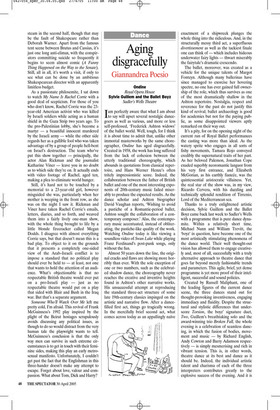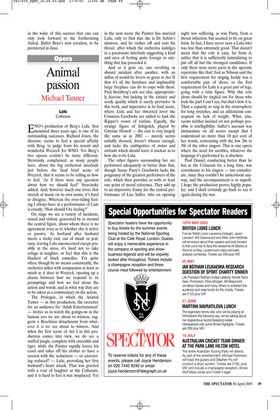Aging disgracefully
Giannandrea Poesio
Ondine Royal Opera House Sylvie Guillem and the Ballet Boyz Sadler’s Wells Theatre Iam perfectly aware that what I am about to say will upset several nostalgic dancegoers as well as various, and more or less self-professed, ‘Frederick Ashton widows’ of the ballet world. Well, tough, for I think it is about time to admit that, unlike other immortal masterworks by the same choreographer, Ondine has aged disgracefully. Created in 1958, the work has long suffered from the lack of cohesion between the utterly traditional choreography, which abounds in quotations from classical repertoire, and Hans Werner Henze’s often tritely impressionistic score. Indeed, the collaboration between the father of British ballet and one of the most interesting exponents of 20th-century music failed miserably to produce the expected results. As the dance scholar and Ashton biographer David Vaughan reports, ‘Wishing to avoid a pastiche of a Romantic-period ballet, Ashton sought the collaboration of a contemporary composer.’ Alas, the contemporary music accentuated, instead of obliterating, the pastiche-like quality of the work. Watching Ondine today is like viewing a soundless video of Swan Lake while playing Franz Ferdinand’s post-punk songs, only without the fun.
Almost 50 years down the line, the original cracks and flaws are showing more horribly than ever. With the sole exception of one or two numbers, such as the celebrated shadow dance, the choreography never reaches the creative and inventive heights found in Ashton’s other narrative works. His unsuccessful attempt at reproducing the standard three-act structure of some late 19th-century classics impinged on the artistic and narrative flow. After a dancefilled first act, things go tragically wrong. In the mercifully brief second act, what comes across today as an appallingly naïve in the wake of this success that one can only look forward to the forthcoming Naked, Ballet Boyz’s new creation, to be premiered in June. enactment of a shipwreck plunges the whole thing into the ridiculous. And, in the structurally messy third act, a superfluous divertissement as well as the tackiest finale one can think of — which includes hideous underwater fairy lights — thwart miserably the fairytale’s dramatic crescendo.
The ballet, moreover, was created as a vehicle for the unique talents of Margot Fonteyn. Although many ballerinas have since managed to exorcise her hovering spectre, no one has ever gained full ownership of the role, which thus survives as one of the most dramatically shallow in the Ashton repertoire. Nostalgia, respect and reverence for the past do not justify this kind of revival; ballet archaeology is good for academics but not for the paying public, as some disappointed viewers aptly remarked on their way out.
It’s a pity, for on the opening night of the current run of Royal Ballet performances the casting was more than ideal. As the watery sprite who engages in all sorts of fishy movements, Tamara Rojo conveyed credibly the supernatural traits of her part. As her beloved Palemon, Jonathan Cope exuded superbly neoromantic languor from his very first entrance, and Elizabeth McGorian, as his earthly fiancée, was the quintessential aristocratic villainess. Yet, the real star of the show was, in my view, Ricardo Cervera, with his dazzling and technically splendid rendition of Tirrenio, Lord of the Mediterranean sea.
Thanks to a truly enlightened artistic decision, Sylvie Guillem and the Ballet Boyz came back last week to Sadler’s Wells with a programme that is pure dance dynamite. Within a relatively short time, Michael Nunn and William Trevitt, the ‘boyz’ in question, have become one of the most artistically stimulating phenomena of the dance world. Their well thought-out vision has allowed them to engage creatively and, most of all, successfully with a truly alternative approach to theatre dance that goes far beyond merely fashionable trends and parameters. This agile, brief, yet dense programme is yet more proof of their intelligent, successful and sound policies.
Created by Russell Maliphant, one of the leading figures of the current dance scene, the three dances stand out for thought-provoking inventiveness, engaging immediacy and fluidity. Despite the structural and stylistic differences that underscore Torsion, the boyz’ signature duet, Two, Guillem’s breathtaking solo and the award-winning trio Broken Fall, the whole evening is a celebration of seamless dancing, in which the fusion of bodies, movement and music — by Richard English, Andy Cowton and Barry Adamson respectively — is simply mesmerising and rich in vibrant tension. This is, in other words, theatre dance at its best and dance as it should be. Indeed, the individual artistic talent and charisma of each of the three interpreters contributes greatly to the explosive success of the evening. And it is





















































 Previous page
Previous page